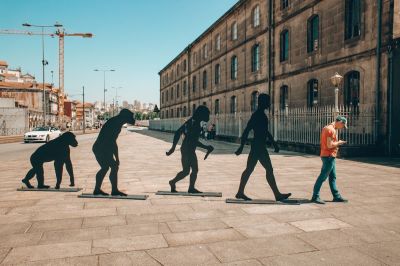
A myth repeated so often in museums, textbooks, and nature documentaries that most people accept it as dogma is that humans and chimpanzees share 98% to 99% of our DNA. The Smithsonian Museum of Natural History in Washington, D.C., for example, cites this statistic in its Human Origins exhibit as confirmation that “modern humans and chimpanzees diverged from a common ancestor between 8 and 6 million years ago.”
The only problem is the statistic is wrong, likely by an order of magnitude. Even more, the science community has known that it is wrong for a while now, and new methods of comparing the genomes of humans and great apes show just how genetically different the two are. In fact, the cited 1% to 2% difference hasn’t really been defensible in years.
As far back as 2007, authors in the journal Science called on fellow researchers to retire “the myth of 1%.” Geologist Casey Luskin explained, in a 2023 ID the Future podcast, that the estimate was derived decades ago from a single protein-to-protein comparison before the chimp genome was even fully sequenced. Since then, genetic science has become far more precise, and almost no modern comparisons between human and chimp genomes yield the famous 98% to 99% statistic.
More precise methods for comparing genomes show the actual difference between humans and chimps to be far higher than what is constantly quoted. In April, a “groundbreaking” paper published in the journal Nature gives the complete sequences of various ape genomes not compiled using the human genome as a guide. As Evolution News put it, this data reveals that “humans and chimps differ by at least 14[%], a major revision of the old statistic.” Luskin, an associate director at the Center for Science and Culture, had to break this “bombshell story” because the comparison was—for some strange reason—“buried deep in the 174-page-long Supplementary Data” of the paper.
The authors derived the new figure by using a method called “Progressive Cactus alignment,” which allowed them to compare human and ape genomes directly across their entire length. Which parts of the genome they compared affected the number of differences. As Luskin wrote, “only 84.95[%] of the nucleotides in the chimp genome had an identical 1:1 correspondence with the human genome,” yielding a haploid genomic difference of just over 15%.
The diploid alignment was even more dramatically divergent, showing a difference of 16.11% between humans and chimps. When sex chromosomes were analyzed, chimpanzee X chromosomes were over 20% different from ours, and Y chromosomes were an astonishing 95.68% different!
In an open letter to the Smithsonian, Luskin highlighted the research and urged them to correct the now debunked statistic in the Human Evolution exhibit. The number cited, he wrote, is “no longer scientifically accurate,” and “leaves the average reader with the false impression that there is only 1.2[%] genetic difference between modern humans and chimpanzees.” Given recent findings, the Smithsonian and other museums have “no business” claiming that DNA evidence strongly supports common ancestry. No word yet on when the museum plans to correct the exhibit.
Far from being “settled science,” the idea that humans are nearly genetically identical to apes is what author Jonathan Wells has called an “icon of evolution.” These are images or concepts fixed in the public imagination which bias them toward Darwinian explanations, even long after science has moved on. It might also be called a zombie idea, which should be dead but keeps moving around and causing problems.
Even more important, the assumption that genetic resemblance between humans and animals means we must be evolved animals depends on genetic reductionism. This idea that we are merely the sum of our genes is itself a matter of materialistic faith and misinterprets the substantive evidence for design in the human body. No matter the degree of genetic similarity, there remains, as Luskin put it, “a vast cognitive and behavioral gulf” between humans and apes. Humans write scientific papers about chimpanzees, not the other way around! Humans compose music, create art, build cathedrals, use complex technology, are religious, and write symphonies.
Besides, any biological similarity between humans and apes can just as easily be explained as the mark of common design. Every engineer knows that a good blueprint can be reused and repurposed. We should expect living things to share similarities if they share a design and an infinitely wise and creative Designer.
It’s time this icon is retired. It’s time this zombie is killed. Repeating that something is “settled science” does not make it or its materialistic conclusions so.
Originally published at BreakPoint.
John Stonestreet serves as president of the Colson Center, equipping Christians to live with clarity, confidence, and courage in today’s cultural moment. A sought-after speaker and author on faith, culture, theology, worldview, education, and apologetics, he has co-authored five books, including A Practical Guide to Culture, A Student’s Guide to Culture, and Restoring All Things. John hosts Breakpoint, the nationally syndicated commentary founded by Chuck Colson, and The Point, a daily one-minute feature on worldview and cultural issues. Previously, he held leadership roles at Summit Ministries and taught biblical studies at Bryan College (TN). He lives in Colorado Springs, Colorado, with his wife, Sarah, and their four children.
Shane Morris is a senior writer at the Colson Center, where he has been the resident Calvinist and millennial, home-school grad since 2010, and an intern under Chuck Colson. He writes BreakPoint commentaries and columns. Shane has also written for The Federalist, The Christian Post, and Summit Ministries, and he blogs regularly for Patheos Evangelical as Troubler of Israel.
















